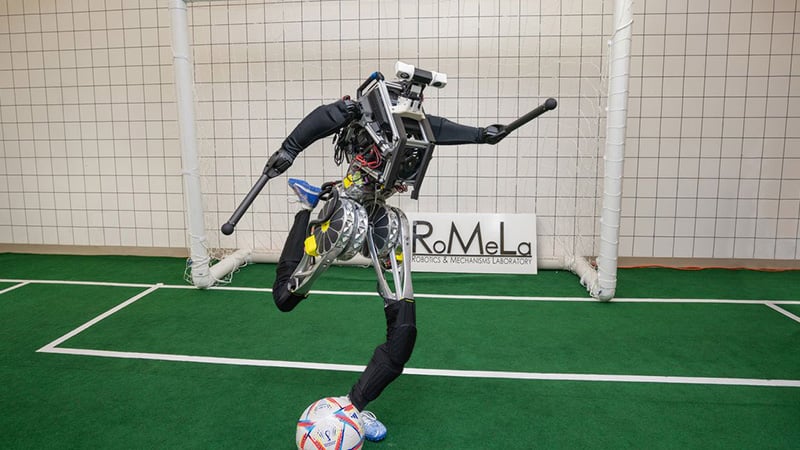 UCLA created the first ever humanoid soccer-playing robot and named it after the Greek goddess of hunt, ARTEMIS. Credit: UCLA Samueli School of Engineering.
UCLA created the first ever humanoid soccer-playing robot and named it after the Greek goddess of hunt, ARTEMIS. Credit: UCLA Samueli School of Engineering.A team of mechanical engineers from UCLA Samueli School of Engineering has created an impressive humanoid robot named ARTEMIS, which stands for Advanced Robotic Technology for Enhanced Mobility and Improved Stability.
ARTEMIS is the first of its kind to be equipped with such technology. This full-sized robot is set to participate in the soccer competition of the 2023 RoboCup, an international event where robots showcase their abilities across a range of categories.
General characteristics of ARTEMIS
The Robotics and Mechanisms Laboratory at UCLA, also known as RoMeLa, designed ARTEMIS to be a general-purpose humanoid robot with a particular focus on bipedal locomotion over uneven surfaces.
ARTEMIS is 4 feet, 8 inches tall and weighs 85 pounds, and can walk, run, and jump on rough and unstable terrain. ARTEMIS is steady even when it’s strongly pushed or otherwise disturbed.
During lab tests, UCLA researchers have recorded ARTEMIS walking at 2.1 meters per second, which would make it the world’s fastest-walking humanoid robot.
ARTEMIS is also believed to be the first humanoid robot created in an academic setting capable of running and only the third overall.
In July, ARTEMIS will travel to Bordeaux, France, to participate in the soccer competition at the 2023 RoboCup.
ARTEMIS: Soccer-playing humanoid robot is ready!#BitsServer pic.twitter.com/BUM3xn2urE
— BitsServer IT Lab (@bitsserver) April 19, 2023
Customized to act like biological muscles
Unlike most robots that have stiff movements, this robot’s actuators, which are the devices that make it move, were made to work like biological muscles.
It means that they are flexible and can sense the amount of force needed to move rather than just the position it needs to be in.
Dennis Hong, a professor at UCLA who helped create the robot, said that this is what makes it so good at balancing and moving on uneven ground. The robot can also run by lifting both feet off the ground while in motion. This is the first time a robot has been designed in this way.
Another feature of the robot is that it uses electricity to power its movements, rather than hydraulics, like most other robots. This makes it quieter and more efficient and also avoids the problem of leaking fluids, according to UCLA.
The robot also has a system of sensors that allow it to sense its surroundings and respond to them. It has force sensors in its feet to help it stay balanced, as well as cameras in its head to help it see where it is going.
Named after Greek goddess of hunt
The team at RoMeLa decided to give the humanoid robot the name ARTEMIS, which is inspired by the Greek goddess of the hunt, wild animals, chastity, and childbirth. Moreover, the members of RoMeLa, refer to the robot as “she.”
The development of ARTEMIS was made possible with funding from various sources, including a crowdfunding campaign on UCLA Spark, where 232 donors contributed more than $118,000. The project also received additional support from an Office of Naval Research grant.

 1 year ago
98
1 year ago
98











 English (US)
English (US)